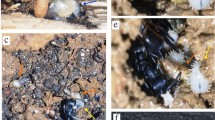Summary
We have investigated the occurrence of cohabitation of several females in the same nest ofXylocopa suspecta, X. frontalis andX. grisescens which are the most common species in the region of Ribeirão Preto, S.P., Brazil. The study of social behaviour of these species involved, as a general procedure, the identification of each associated female in relation to its foraging and reproductive activity. It was observed that in each species the association of females started at the final phase of the biological cycle, when the reactivation of the nests began. Initially the association was observed to occur among mother and daughters. Subsequently only daughters remained in the nest and in the first phase of this association only one female (generally the eldest), was able to realize oviposition. Next, two ore more females were in the same condition, provisioning and ovipositing in only one cell. In the third phase the females had all the same condition, each one of them provisioning and ovipositing in their own cells. So, in the first and second phases the social behaviour corresponds to the semisocial and quasisocial levels, respectively. Nevertheless, this behaviour was transitory and the final pattern attained was communal.
Zusammenfassung
Wir haben das Zusammenleben von meheren Weibchen in Nestern vonXylocopa suspecta, X. frontalis undX. grisescens, den häufigsten Arten in der Region von Ribeirão Preto, S.P., Brasilien, untersucht. Nahrungssammeln und Fortpflanzung der Weibchen wurde als Maß für das Sozialverhalten gewertet.
Die Bildung einer Gemeinschaft begann am Ende des biologischen Zyklus', wenn die Nester erneut benutzt wurden. Zu Beginn bestanden die Gemeinschaften aus der Mutter und ihren Töchtern. Anschließend waren nur die Töchter im Nest, von denen eine, gewöhnlich das älteste Weibchen, Eier legte (erste Phase). Im nächsten Stadium waren zwei oder mehr Weibchen in der Lage, Eier zu legen; sie versorgten gemeinsam dieselben Zellen mit Nahrung und legten Eier. In der dritten Phase legten alle Weibchen Eier, jede versorgte aber ihre eigenen Zellen. Das Sozialverhalten in der ersten Phase wird als semisozial, das Verhalten in der zweiten Phase als quasisozial angesehen. Diese Verhaltensmuster traten jedoch nur vorübergehend auf, denn im letzten Stadium zeigten die Weibchen ein kommunales Sozialverhalten.
Similar content being viewed by others
References
Anzemberger G., 1977. — Ethological study of African carpenter bees of the genusXylocopa (Hymenoptera, Anthophoridae).Z. Tierpsychol., 44, 337–374.
Ben Mordechai Y., Cohen R., Gerling D., Moscovitz E., 1978. — The biology ofXylocopa pubescens Spinola (Hymenoptera, Anthophoridae) in Israel.Israel J. Entomol., 12, 107–121.
Bonelli B., 1974. — Osservazioni eto-ecologiche sugli Imenotteri aculeati dell'Etiopia VI.Boll. Inst. Entomol. Univ. Bologna, 32, 105–132.
Bonelli B., 1976. — Osservazioni eto-ecologiche sugli Imenotteri aculeati dell'Etiopia VII.Boll. Inst. Entomol. Univ. Bologna, 33, 1–31.
Camargo J.M.F., Velthuis H.H.W., 1979. — Sobre o comportamento deXylocopa (Megaxylocopa) frontalis (Olivier) (Hymenoptera, Anthophoridae).Dusenia, 11 (1), 35–39.
Camillo E., Garófalo C.A., 1982. — On the bionomics ofXylocopa frontalis (Olivier) andXylocopa grisescens. (Lepeletier) in Southern Brazil. I. Nest construction and biological cycle.Rev. Brasil. Biol., 42, (3), 571–582.
Camillo E. Garófalo C.A., Muccillo G., 1986. — On the bionomics ofXylocopa suspecta (Moure) in Southern Brazil: Nest construction and biological cycle (Hymenoptera, Anthophoridae).Rev. Brasil. Biol., 46 (2), 383–393.
Gerling D., Hermann H.R., 1978. — Biology and mating behavior ofXylocopa virginica L. (Hymenoptera, Anthophoridae).Behav. Ecol. Sociobiol., 3, 99–111.
Gerling D., Hurd P.D., Hefetz A., 1981. — In nest behavior of the carpenter bee,Xylocopa pubescens Spinola (Hymenoptera, Anthophoridae).J. Kansas Entomol., Soc., 54 (2), 209–218.
Gerling D., Hurd P.D., Hefetz A., 1983. — Comparative behavioral biology of two Middle East species of carpenter bees (Xylocopa Latreille) (Hymenoptera, Apoidea).Smithsonian Contributions to Zoology, 369, 1–33.
Hurd P.D., 1958. — Observations on the nesting habits of some New World carpenter bees with remarks on their importance in the problem of species formation (Hymenoptera, Apoidea).Ann. Entomol. Soc. Am., 51, 365–375.
Hurd P.D., Moure J.S., 1960. — A New World subgenus of bamboo-nesting carpenter bees belonging to the genusXylocopa Latr.Ann. Entomol. Soc. Am., 53, 809–821.
Hurd P.D., Moure J.S., 1963. —A classification of the large carpenter bees (Xylocopini) (Hymenoptera, Apoidea). University of California, USA, 22, 365 pp.
Iwata K., 1964. — Egg giantism in sub-tropical Hymenoptera, with ethological discussion on tropical bamboo carpenter bees.Nature et Life S.E. Asia, 3, 399–431.
Michener C.D., 1974. —The social behavior of the bees. Harvard University Press, Cambridge, Massachusetts, 404 pp.
Moure J.S., Camargo J.M.F., 1987. — Uma nova espécie deXylocopa (Neoxylocopa) do Brasil.Rev. Brasil. Entomol., in press.
Sakagami S.F., Laroca S., 1971. — Observations on the bionomics of some neotropical Xylocopinae bees, with comparative and biofaunistic notes (Hymenoptera, Anthophoridae).J. Fac. Hokkaido Univ., VI Zool.,18 (1), 57–127.
Velthuis H.H.W., 1987. — The evolution of sociality: ultimate and proximate factors leading to primitive social behavior in carpenter bees. In:From individual to collective behavior in social insects (Pasteels, J.M. and Deneubourg, J.L. eds.)Experientia Supplementum, 54, 405–430, Birkhäuser Verlag, Basel.
Velthuis H.H.W., Gerling D., 1983. — At the brink of sociality: interactions between adults of the carpenter beeXylocopa pubescens Spinola.Behav. Ecol. Sociobiol., 12, 209–214.
Watmough R.H., 1974. — Biology and behavior of carpenter bees in Southern Africa.J. Entomol. Soc. South Afr., 37 (2), 261–281.
Author information
Authors and Affiliations
Rights and permissions
About this article
Cite this article
Camillo, E., Garofalo, C.A. Social Organization in reactivated nests of three species ofXylocopa (Hymenoptera, Anthophoridae) in southeastern Brasil. Ins. Soc 36, 92–105 (1989). https://doi.org/10.1007/BF02225905
Received:
Accepted:
Issue Date:
DOI: https://doi.org/10.1007/BF02225905




